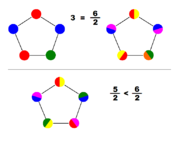
Fractional coloring
Encyclopedia

Graph theory
In mathematics and computer science, graph theory is the study of graphs, mathematical structures used to model pairwise relations between objects from a certain collection. A "graph" in this context refers to a collection of vertices or 'nodes' and a collection of edges that connect pairs of...
known as fractional graph theory. It is a generalization of ordinary graph coloring
Graph coloring
In graph theory, graph coloring is a special case of graph labeling; it is an assignment of labels traditionally called "colors" to elements of a graph subject to certain constraints. In its simplest form, it is a way of coloring the vertices of a graph such that no two adjacent vertices share the...
. In a traditional graph coloring, each vertex in a graph is assigned some color, and adjacent vertices — those connected by edges — must be assigned different colors. In a fractional coloring however, a set of colors is assigned to each vertex of a graph. The requirement about adjacent vertices still holds, so if two vertices are joined by an edge, they must have no colors in common.
Fractional graph coloring can be viewed as the linear programming relaxation of traditional graph coloring. Indeed, fractional coloring problems are much more amenable to a linear programming approach than traditional coloring problems.
Definitions

An a:b-coloring is a b-fold coloring out of a available colors.
The b-fold chromatic number χb(G) is the least a such that an a:b-coloring exists.
The fractional chromatic number χf(G) is defined to be

Note that the limit exists because χb(G) is subadditive
Subadditive function
In mathematics, subadditivity is a property of a function that states, roughly, that evaluating the function for the sum of two elements of the domain always returns something less than or equal to the sum of the function's values at each element. There are numerous examples of subadditive...
, meaning χa+b(G) ≤ χa(G) + χb(G).
Some properties of χf(G):

and

Here n(G) is the order of G, α(G) is the independence number, ω(G) is the clique number, and χ(G) is the chromatic number.
Linear Programming (LP) Formulation
The fractional chromatic number χf(G) of a graph G can be obtained as a solution to the linear programLinear programming
Linear programming is a mathematical method for determining a way to achieve the best outcome in a given mathematical model for some list of requirements represented as linear relationships...
- minimize

- subject to
 for each vertex
for each vertex  ,
,
in which
 is a variable associated with the independent set
is a variable associated with the independent setIndependent set (graph theory)
In graph theory, an independent set or stable set is a set of vertices in a graph, no two of which are adjacent. That is, it is a set I of vertices such that for every two vertices in I, there is no edge connecting the two. Equivalently, each edge in the graph has at most one endpoint in I...
 .
.The linear program has a dual that calculates "fractional clique number", a relaxation to the rationals of the integer concept of clique number. The strong duality theorem of linear programming guarantees that solutions to both linear programs do exist. However, each linear program has size that is exponential in the number of vertices of G, and computing the fractional chromatic number of a graph is NP-hard
NP-hard
NP-hard , in computational complexity theory, is a class of problems that are, informally, "at least as hard as the hardest problems in NP". A problem H is NP-hard if and only if there is an NP-complete problem L that is polynomial time Turing-reducible to H...
. This stands in contrast to the problem of fractionally coloring the edges of a graph, which can be solved in polynomial time thanks to the simple structure of the matching polytope.
Applications
Applications of fractional graph coloring include activity scheduling. In this case, the graph G is a conflict graph: an edge in G between the nodes u and v denotes that u and v cannot be active simultaneously. Put otherwise, the set of nodes that are active simultaneously must be an independent set in graph G.An optimal fractional graph coloring in G then provides a shortest possible schedule, such that each node is active for (at least) 1 time unit in total, and at any point in time the set of active nodes is an independent set. If we have a solution x to the above linear program, we simply traverse all independent sets I in an arbitrary order. For each I, we let the nodes in I be active for
 time units; meanwhile, each node not in I is inactive.
time units; meanwhile, each node not in I is inactive.In more concrete terms, each node of G might represent a radio transmission in a wireless communication network; the edges of G represent interference between radio transmissions. Each radio transmission needs to be active for 1 time unit in total; an optimal fractional graph coloring provides a minimum-length schedule (or, equivalently, a maximum-bandwidth schedule) that is conflict-free.
Comparison with traditional graph coloring
If one further required that each node must be active continuously for 1 time unit (without switching it off and on every now and then), then traditional graph vertex coloring would provide an optimal schedule: first the nodes of color 1 are active for 1 time unit, then the nodes of color 2 are active for 1 time unit, and so on. Again, at any point in time, the set of active nodes is an independent set.In general, fractional graph coloring provides a shorter schedule than non-fractional graph coloring; there is an integrality gap. It may be possible to find a shorter schedule, at the cost of switching devices (such as radio transmitters) on and off more than once.

